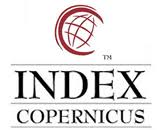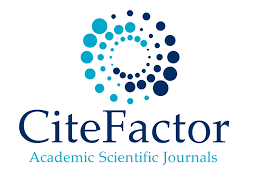Le Développement De L’Intermédiation Financière Et La Croissance Économique : Cas De Madagascar (1980-2020)
Abstract
Keywords
Full Text:
PDFReferences
. Brender et al 2015, monnaie, finance et économie réelle la Découverte, 2015, 128p
Agenor,P,R. 2003, « Benefits and Costs of international Financial Integration : Theory and
Facts », World Economy,Vol.26,Issue 8,pp.1089-1118.
Aghion P., Bolton P., 1997. « A Theory of Trickle-Down Growth and Development »,
Review of Economic Studies, 151-172.
Aghion P., Howitt P., Mayer-foulkes D, 2004. « The Effect of Financial Development on
Convergence : Theory and Evidence », NBER Working Paper 10358, mars 2004.
Aglietta M., 2005. Macroéconomie financière, éd la Découverte, Paris. 130 p.
Alain B., Christophe R, 2017, Economie monétaire, théories et politiques, Armand colin,
Dunod, Paris.
Allen, F., & Gale, D., 2000. Comparing financial systems, 40. Cambridge : MA : MIT Press.
Andreas S, Samuel M, Ibrahim S, 2021. « Ownership and bank efficiency in African : True
fixed effects stochastic frontier analysis », Journal of Financial Stability 54, pp.1-12.
Avoutou, M., 2019. « Lien entre développement financier et croissance économique : la
fragmentation ethnique, un handicap ?», Revue "Repères et Perspectives
Economiques", Vol.3, N° 2 / 2ème semestre 2019.
Barro R.J., 1991, « Economic Growth in a Cross Section of Countries », Quarterly Journal
of Economics, 106, pp. 407-443.
Beck Thorsten, 2003, “Financial Dependence and International Trade”, Review of
International Economics, Volume 11.
Berthelemy J.C., Varoudakis A. 1996, Economic Growth, Convergence Clubs, and the Role
of Financial Development, Oxford Economic Papers, New Series, Vol. 48,n° 2, 1996.
Belinga Thierrya, Zhou Junb, D Doumbe Eric and al, 2016. « causality relationship between
bank credit and economic growth: evidence from a time series analysis on a vector
error correction model in Cameroon », Procedia - Social and Behavioral Sciences
, pp. 664 – 671.
Boyd, J. H., & Smith, B. D., 1998. « The evolution of debt and equity markets in economic
development ». Economic Theory, 12(3), 519.
Charles A. E. Good hart, 2004. « Financial Development And Economic Growth :
Explaining the Links », Palgrave Mac Millan, New York, 248p.
Chen HAO, 2006. « Development of financial intermediation and economic growth: The
Chinese experience », China Economic Review 17.
Daniel Cohen, Le monde est clos et le désir infini, Albin Michel, 2015, 224 p.
De Lima, P., 2012. Économie bancaire et croissance économique, éd Dunod, Paris, 220p.
Demetriades,P.O, Law, S.H., 2006 . « Finance, institutions and economique
development ». International journal of finance and economics, 11(3), pp.245-260.
Demetriades,P.O, James,G.A., 2011. « Finance and growth in Africa : The broken link ».
Economic Letters 113.
Demirguc¸-Kunt and Ross Levine, 2001. « Financial structure and economic growth : a
cross-country comparison of banks, markets, and development », The MIT Press
Cambridge, London, 410p.
Dietsch, M. 1992, Quel modèle de concurrence dans l'industrie bancaire?. Revue
économique, 229-260.
Dominique G., Pierre R., 2003, « Les nouvelles théories de la croissance ». – 5e éd. – Paris
: La Découverte, 112 p.
Eber Nicolas. (2000). « Efficience du système bancaire, structure du marché de crédit et
activité économique ». In: Revue économique, volume 51, n°6, pp. 1333-1353.
Ekodo Raymond, 2018, « Impact de la croissance démographique sur la croissance
économique : les résultats d’une étude empirique menée en zone CEMAC », Journal
of Economics and Development Studies, Vol.6, N° 3, pp. 26-35.
Esso, L. J., 2009. La dépendance démographique est-elle un obstacle à l’épargne et à la
croissance en Côte d’Ivoire ? L'Actualité économique, 85(4), pp. 361–382.
https://doi.org/10.7202/045069a.
Gerschenkron A., 1962. « Economic backwardness in historical perspective : a book of
essays ». Belknap Press of Harvard University Press Cambridge, MA.
Goldsmith, R.W., 1969. “Financial Structure and Development.” New Haven: National
Bureau of Economic Research.
Greenwood, Jeremy, et Boyan Jovanovic, 1990. « Financial development, growth, and the
distribution of income ». Journal of political Economy 98 (5, Part 1): pp. 1076– 1107.
Granger C.W.J. et Newbold P., 1974, « Spurious regression in econometrics », Journal of
Econometrics, vol.2, n°2, pp. 111-120.
Gurley J. et Shaw E., 1960, Money in a Theory of Finance, Brookings Institution.
Hamidou S, 2021, « Effets de la corruption sur l’activité bancaire en Afrique Subsaharienne
», Revue internationale des économistes de langue française, Vol.6, N°1, pp 80-98.
Clarke G., Cull R. et Martinez P. S., 2002. « Does Foreign Bank Penetration Reduce Access
to Credit in Developing Countries? Evidence from Asking Borrowers ? , Working
Paper n° 2716, World Bank.
Jensen, M. 1993. « The modern industrial revolution, exit, and control systems ». The
Journal of Finance, 48(3), 831e880. https://doi.org/10.1111/j.1540-6261.
tb04022. x.
Razafindravonona Jean, Rakotonirainy Miora, Rasolomanana Christian, 2020. « Macro
Stress Testing Credit Risk : Case of Madagascar Banking Sector », Journal of Central
Banking Theory and Practice, pp. 199-218.
Ji Wu, Yao Yao , Minghua Chen , Bang Nam Jeon, 2020. « Economic uncertainty and bank
risk: Evidence from emerging economies, Journal of International Financial Markets
», Institutions & Money, Elsevier,pp. 1-32.
Johnson BF, mellor JW, 1961 « The role of agriculture in economic development, American
Econ Rev 51, pp 563-593.
Jonas Kibala Kuma, 2018. Modélisation ARDL, Test de cointégration aux bornes et
Approche de TodaYamamoto : éléments de théorie et pratiques sur logiciels. Licence.
Congo-Kinshasa.
Jude C. Eggoh, Patrick Villieu, 2013. « Un réexamen de la non-linéarité entre le
développement financier et la croissance économique », « Revue d'économie
politique », 2013/2, Vol. 123, pp 211 à 236.
LaajouL. M. & oulhaj. L., 2021. « Développement financier et croissance économique : le
cas de la Chine », Revue Française d’Economie et de Gestion « Volume 2 : Numéro
» pp : 136 – 151.
Lan Khanh Chu, 2020. « Financial structure and economic growth nexus revisited », Borsa
_Istanbul Review, Elsevier, pp. 25-36.
Levine, R. (2005). Finance and Growth: Theory and Evidence. Handbook of Economic
Growth, 1.
Levine R 1996, « Financial Development and Economic Growth », Views and Agenda, The
World Bank, Policy Research Department, Working Paper 1678, 1996
Levine R., Zervos S., Stock Markets, Banks, and Economic Growth, American
Economic Review, 1998.
Levine, R., Loayza, N., & Beck, T. 1999. « Financial intermediation and growth: causality
and causes »(Vol. 310). World Bank Publications.
Li, Hongyi, Lyn Squire and Heng-fu ZOU. (1998), « Explaining international and
intertemporal variations in income inequality », journal économique 108: 26-43.
Lelart, M. (2005). De la finance informelle à la microfinance. Archives contemporaines.
Loyaza, N et Rancière, R (2006). « Financial development, financial fragility and growth ».
Journal of Money, credit and banking.38(4), p.1051-1076.
Jalil, A., Feridun, M., & Ma, Y. 2010. Finance-growth nexus in China revisited: New
evidence from principal components and ARDL bounds tests. International Review
of Economics & Finance, 19(2), 189-195.
King, R.G., Levine, R., 1993. “Finance, entrepreneurship, and growth: Theory and
evidence”. Journal of Monetary Economics 32, pp. 513–542.
King R G., Levine R., 1993, Finance and Growth: Schumpeter Might be Right, The
Quaterly Journal of Economics, Vol. 108, n° 3, 717-737.
Kenza, M. Mohamed,B. 2015. « Financial development economic growth in Algeria : An
economic nalys of the transmission channels ». EPRA International Journal of
Economic an Business review, Vol.3.
Kuipou, T. C., Nombot, N L. et Tafah, E.O.E., 2015. « Developpement financier et
croissance économique dans les pays africains de la zone Franc : le rôle de la
gouvernance ». European scientific journal, vol.11, n° 2, pp. 131-159.
Kpodar, K. (2006). Développement financier, instabilité financière et croissance
économique : implications pour la réduction de la pauvreté (Doctoral dissertation,
Université d'Auvergne-Clermont-Ferrand I).
Mankiw G., Romer D. et Weil D.N., 1990. « A Contribution to the Empirics of Economic
Growth », NBER, nº 3541.
McKinnon, R., 1973. “Money and Capital in Economic Development”. The Brookings
Institute, Washington.
M’hamed Ali Khemakhem, 2010, « Développement des systèmes financiers et croissance
économique : cas des pays en voie de développement », pp. 218-239.
Razafindrakoto Mireille, Roubaud François, Jean-Michel Wachsberger, 2018, L’énigme et
le paradoxe, Économie politique de Madagascar, IRD, Marseille, 240p
Mishkin F., 2013, Monnaie, banque et marchés financiers, éd Nouveaux Horizons, Paris,
p.
Mcgath T., 2019, « M-Pesa : How Kenya Revolutionzed Mobile Payments », mag.n26.com,
consulté le 09 septembre 2021.
Merton Robert C., 1990, “The Financial System and Economic Performance”, Journal of
Financial Services Research, pp. 263-300
Mohamed Ilyes Gritli, Serge Rey, 2017. Quel impact de la libéralisation du compte capital
sur le développement financier en Tunisie ? Les enseignements d’un modèle ARDL,
pp. 1-23.
Noula A. G., Bkwayep Nguemnang Y. Rodrigue, Dr Mba Fokwa Arsène, 2016, « influence
de la bancarisation et du crédit bancaire sur la croissance économique dans la zone
CEMAC », pp. 373-385.
Pagano M., 1993, “Financial Markets and Growth: an Overview”, European Economic
Review, vol. 37, n° 2-3, 04, pp. 613-622.
Panizza U, 2017. « Non-linéarités dans la relation entre finance et croissance, Revue
d'économie financière », 2017/3 N° 127 | pp. 83 à 94.
Patrick H. (1966), Financial Development and Economic Growth in Underdeveloped
Countries. EconomicDevelopment and Cultural Change, Vol.14, pp. 174-189
Pierre Jacquet, Jean-Paul Pollin, 2012. « Systèmes financiers et croissance », Revue
d'économie financière 2012/2 (N° 106), pp. 77-110. DOI 10.3917/ecofi.106.0077.
Pesaran, M.H., Shin, Y and Smith, R., 2001, “Bounds testing approaches to the analysis of
level relationships”. Journal of Applied Econometrics 16, pp. 289-326.
Pradhan, R.P., 2018. « Are innovation and financial development causative factors in
economic growth? Evidence from a panel granger causality test », Technological
Forecasting & Social Change, pp1-10
Rajan, Raghuram G. and Luigi Zingales. (2003), « The Great Reversals: The politics of
financial development in the 2Oth century ». Forthcoming. jourmal of Financial
Economics 69: pp. 5-50.
Robinson J., 1952, “The Generalization of General Theory,” in The rate of interest, and other
essays. London : Macmillan, pp.67-142
Sambou, A.M., Fahad, A., 2021, « Quel sens de causalité entre la croissance économique
et le crédit intérieur au secteur privé : cas du Sénégal (1980-2018)», Revue "Repères
et Perspectives Economiques" [En ligne], Vol. 5, N° 1.
SAHAY R., et al. 2015, « Rethinking Financial Deepening: Stability and Growth in
Emerging Markets », FMI, Note de discussion du personnel du FMI 15/08
Sène, B., 2018. « La relation entre finance et croissance revisitée dans les pays de l’Afrique
Subsaharienne : banque versus marchés financiers ». L’Actualité économique, Revue
d’analyse économique, vol. 94, n°1, mars, pp. 1-29.
Sekali, J., & Bouzahzah, M., 2021. « Développement financier et croissance économique :
Cas du Maroc ». International Journal of Accounting, Finance, Auditing,
Management and Economics, 2(3), 95-108. https://doi.org/10.5281/zenodo.4792331.
Shaw, E., 1973. “Financial Deepening in Economic Development”, New York: Oxford
University Press.
Shumpeter,1912, Théorie de l'évolution économique. Recherches sur le profit, le crédit,
l'intérêt et le cycle de la conjoncture
Stiglitz, J. E. 1985. Credit markets and the control of capital. Journal of Money, credit and
Banking, 17(2), 133-152.
Tadesse S., 2002, « Financial Architecture and Economic Performance : International
Evidence », Journal of Financial Intermediation, pp. 429-454.
Turunç G, 1999. « Développement du secteur financier et croissance : le cas des pays
émergents méditerranéens ». Revue région et développement n°10, pp 90-129.
Beck Thorsten, Aslı Demirgüç-Kunt and Ross Levine, 2019, Financial Development and
Structure Dataset .
Vetsonavalona R, Lantoniaina R, 2015. Les défis de la politique industrielle à Madagascar,
Friedrich Elbert Stiftung. Antananarivo, Madagascar.
Weill, L. (2006). Propriété étrangère et efficience technique des banques dans les pays en
transition. Revue économique, 57(5), 1093-1108.
Wang. J., 1990, « Growth technology transfer, and the long-run theory of international
capital movements », Journal of International Economics, vol. 29
World Bank, 2021, World Development Indicators database. http://Worldbank.org/WDI/.
Consulte le 23 septembre 2021.
Rapports et document divers
BFM, 2018 -2021, Enquête auprès du secteur bancaire 4 -ème trimestre de 2018-2020, 2
ème trimestre 2021.
BFM, 2010-2020, Rapport annuel de la banque centrale de 2010-2020.
BFM, 2018, Rapport sur la stabilité financière n°06.
Fond Monétaire International, 2016, « Evaluation de la stabilité du secteur financier ».81p
INSTAT, ILO, 2012, Enquête nationale sur l’emploi et le secteur informel (ENEMPSI
INSTAT, Mastercard, « work4youth », 2015, Enquête sur la transition des jeunes
vers la vie active ETVA Madagascar.
INSTAT, MEFB, USAID, 2005, Rapport de l’enquête sur les entreprises à Madagascar
INSTAT, 2021, Tableau de bord économique 2020.
LD Media Developement, EDBM, 2021, Yearbook, rapport économique de Madagascar,
l’émergence malagasy 2021.
PNUD 2003, Rapport d’évaluation du PAMF.90p
UNCDF, 2020, Diagnostic de l’écosystème des services financiers numériques de
MADAGASCAR, 60p.
DOI: http://dx.doi.org/10.52155/ijpsat.v47.1.6692
Refbacks
- There are currently no refbacks.
Copyright (c) 2024 Jean Razafindravonona

This work is licensed under a Creative Commons Attribution 4.0 International License.



















